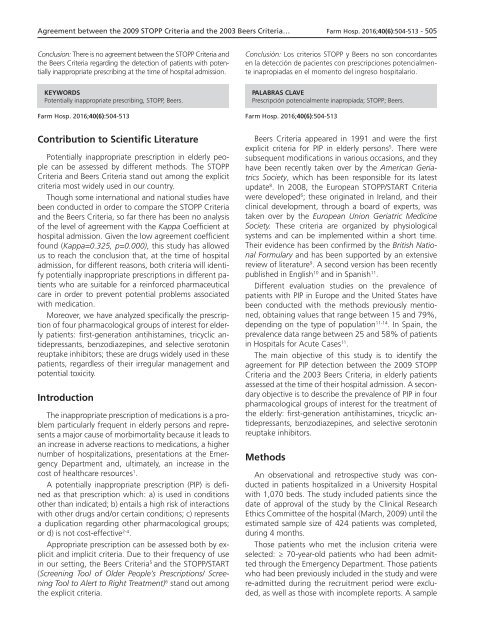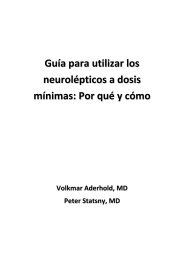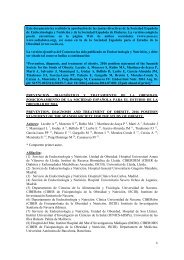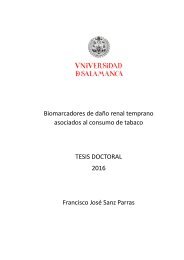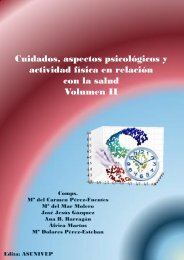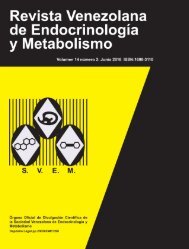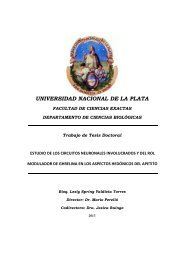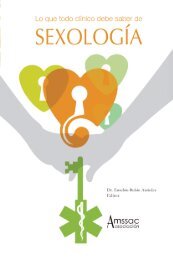Noviembre-Diciembre
156_v40n6(1)
156_v40n6(1)
Create successful ePaper yourself
Turn your PDF publications into a flip-book with our unique Google optimized e-Paper software.
Agreement between the 2009 STOPP Criteria and the 2003 Beers Criteria… Farm Hosp. 2016;40(6):504-513 - 505<br />
Conclusion: There is no agreement between the STOPP Criteria and<br />
the Beers Criteria regarding the detection of patients with potentially<br />
inappropriate prescribing at the time of hospital admission.<br />
Conclusión: Los criterios STOPP y Beers no son concordantes<br />
en la detección de pacientes con prescripciones potencialmente<br />
inapropiadas en el momento del ingreso hospitalario.<br />
KEYWORDS<br />
Potentially inappropriate prescribing, STOPP, Beers.<br />
Farm Hosp. 2016;40(6):504-513<br />
PALABRAS CLAVE<br />
Prescripción potencialmente inapropiada; STOPP; Beers.<br />
Farm Hosp. 2016;40(6):504-513<br />
Contribution to Scientific Literature<br />
Potentially inappropriate prescription in elderly people<br />
can be assessed by different methods. The STOPP<br />
Criteria and Beers Criteria stand out among the explicit<br />
criteria most widely used in our country.<br />
Though some international and national studies have<br />
been conducted in order to compare the STOPP Criteria<br />
and the Beers Criteria, so far there has been no analysis<br />
of the level of agreement with the Kappa Coefficient at<br />
hospital admission. Given the low agreement coefficient<br />
found (Kappa=0.325, p=0.000), this study has allowed<br />
us to reach the conclusion that, at the time of hospital<br />
admission, for different reasons, both criteria will identify<br />
potentially inappropriate prescriptions in different patients<br />
who are suitable for a reinforced pharmaceutical<br />
care in order to prevent potential problems associated<br />
with medication.<br />
Moreover, we have analyzed specifically the prescription<br />
of four pharmacological groups of interest for elderly<br />
patients: first-generation antihistamines, tricyclic antidepressants,<br />
benzodiazepines, and selective serotonin<br />
reuptake inhibitors; these are drugs widely used in these<br />
patients, regardless of their irregular management and<br />
potential toxicity.<br />
Introduction<br />
The inappropriate prescription of medications is a problem<br />
particularly frequent in elderly persons and represents<br />
a major cause of morbimortality because it leads to<br />
an increase in adverse reactions to medications, a higher<br />
number of hospitalizations, presentations at the Emergency<br />
Department and, ultimately, an increase in the<br />
cost of healthcare resources 1 .<br />
A potentially inappropriate prescription (PIP) is defined<br />
as that prescription which: a) is used in conditions<br />
other than indicated; b) entails a high risk of interactions<br />
with other drugs and/or certain conditions; c) represents<br />
a duplication regarding other pharmacological groups;<br />
or d) is not cost-effective 2-4 .<br />
Appropriate prescription can be assessed both by explicit<br />
and implicit criteria. Due to their frequency of use<br />
in our setting, the Beers Criteria 5 and the STOPP/START<br />
(Screening Tool of Older People’s Prescriptions/ Screening<br />
Tool to Alert to Right Treatment) 6 stand out among<br />
the explicit criteria.<br />
Beers Criteria appeared in 1991 and were the first<br />
explicit criteria for PIP in elderly persons 5 . There were<br />
subsequent modifications in various occasions, and they<br />
have been recently taken over by the American Geriatrics<br />
Society, which has been responsible for its latest<br />
update 8 . In 2008, the European STOPP/START Criteria<br />
were developed 6 ; these originated in Ireland, and their<br />
clinical development, through a board of experts, was<br />
taken over by the European Union Geriatric Medicine<br />
Society. These criteria are organized by physiological<br />
systems and can be implemented within a short time.<br />
Their evidence has been confirmed by the British National<br />
Formulary and has been supported by an extensive<br />
review of literature 9 . A second version has been recently<br />
published in English 10 and in Spanish 11 .<br />
Different evaluation studies on the prevalence of<br />
patients with PIP in Europe and the United States have<br />
been conducted with the methods previously mentioned,<br />
obtaining values that range between 15 and 79%,<br />
depending on the type of population 11-14 . In Spain, the<br />
prevalence data range between 25 and 58% of patients<br />
in Hospitals for Acute Cases 11 .<br />
The main objective of this study is to identify the<br />
agreement for PIP detection between the 2009 STOPP<br />
Criteria and the 2003 Beers Criteria, in elderly patients<br />
assessed at the time of their hospital admission. A secondary<br />
objective is to describe the prevalence of PIP in four<br />
pharmacological groups of interest for the treatment of<br />
the elderly: first-generation antihistamines, tricyclic antidepressants,<br />
benzodiazepines, and selective serotonin<br />
reuptake inhibitors.<br />
Methods<br />
An observational and retrospective study was conducted<br />
in patients hospitalized in a University Hospital<br />
with 1,070 beds. The study included patients since the<br />
date of approval of the study by the Clinical Research<br />
Ethics Committee of the hospital (March, 2009) until the<br />
estimated sample size of 424 patients was completed,<br />
during 4 months.<br />
Those patients who met the inclusion criteria were<br />
selected: ≥ 70-year-old patients who had been admitted<br />
through the Emergency Department. Those patients<br />
who had been previously included in the study and were<br />
re-admitted during the recruitment period were excluded,<br />
as well as those with incomplete reports. A sample


